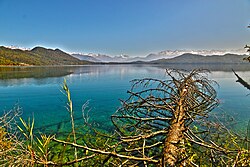Mugu District
Mugu District
मुगु | |
|---|---|
District | |
 | |
 Location of Mugu District (dark yellow) in Karnali | |
| Country | |
| Province | Karnali Pradesh |
| Admin HQ. | Gamgadhi (today part of Chhayanath Rara Municipality) |
| Government | |
| • Type | Coordination committee |
| • Body | DCC, Mugu |
| Area | |
| • Total | 3,535 km2 (1,365 sq mi) |
| Population (2011) | |
| • Total | 55,286 |
| • Density | 16/km2 (41/sq mi) |
| Time zone | UTC+05:45 (NPT) |
| Website | ddcmugu |
Mugu District (Nepali: मुगु जिल्ला![]() Listen (help·info), a part of Karnali province, is one of the seventy-seven districts of Nepal. The district, with Gamgadhi as its district headquarters, covers an area of 3,535 km2 (1,365 sq mi) and had a population (2011) of 55,286.[1] Mugu is known for being both the most remote district in Nepal, as well as the least developed.
Listen (help·info), a part of Karnali province, is one of the seventy-seven districts of Nepal. The district, with Gamgadhi as its district headquarters, covers an area of 3,535 km2 (1,365 sq mi) and had a population (2011) of 55,286.[1] Mugu is known for being both the most remote district in Nepal, as well as the least developed.
Geography and climate[]
Mugu's geography is very rugged. The biggest lake in Nepal, Rara Lake, also known as Mahendra Daha, lies in Mugu District.
It is one of the biggest districts of Nepal. Pulu is one of the famous village development committees (VDC) of Mugu district. There are many villages in this VDC, such as Riusa, Mooh, Mangri, Serog, and Dawra. Similarly, Seri Village Development Committee (VDC) is one of the famous VDCs of the district. It is located west of Rara VDC.[citation needed]
| Climate zone[2] | Elevation range | % of area |
|---|---|---|
| Subtropical | 1,000 to 2,000 meters 3,300 to 6,600 ft. |
5.6% |
| Temperate | 2,000 to 3,000 meters 6,400 to 9,800 ft. |
19.3% |
| Subalpine | 3,000 to 4,000 meters 9,800 to 13,100 ft. |
20.6% |
| Alpine | 4,000 to 5,000 meters 13,100 to 16,400 ft. |
17.7% |
| Nival | above 5,000 meters | 5.3% |
| Trans-Himalayan[3] | 3,000 to 6,400 meters 9,800 to 21,000 ft. |
31.2% |
Tourism[]
The remote Mugu district is rich in natural resources. Nepal's largest Rara Lake lies in this district. Many domestic and international tourists come to visit the famous and beautiful Rara Lake. The lake is also known as the Mahendra Tal. The Lake lies at an elevation of 2,990 meters and covers about 10.8 km2 (4.2 sq mi) of area. The Rara National Park protects and surrounds it.
Demographics[]
At the time of the 2011 Nepal census, Mugu District had a population of 55,286. The main communities in the district are Chhetri (27,400), Thakuri (8,400), Kami (5,200) and Tamang (4,400). Of the total population, 92.34% spoke Nepali, 6.65% Tamang and 0.77% Sherpa as their first language.[5]
Administration[]
The district consists of four municipalities, out of which all are rural municipalities. These are as follows:[6]
- Chhayanath Rara Municipality
- Mugum Karmarong Rural Municipality
- Soru Rural Municipality
- Khatyad Rural Municipality
Former village development committees[]
Prior to the restructuring of the district, Mugu District consisted of the following municipalities and village development committees:

References[]
- ^ "National Population and Housing Census 2011 (National Report)" (PDF). Central Bureau of Statistics. Archived from the original (PDF) on 2013-05-25. Retrieved 1 November 2012.
- ^ The Map of Potential Vegetation of Nepal - a forestry/agroecological/biodiversity classification system (PDF), Forest & Landscape Development and Environment Series 2-2005 and CFC-TIS Document Series No.110., 2005, ISBN 87-7903-210-9, retrieved Nov 22, 2013
- ^ Shrestha, Mani R.; Rokaya, Maan B.; Ghimire, Suresh K. (2005). "Vegetation pattern of Trans-Himalayan zone in the North-West Nepal". Nepal Journal of Plant Sciences. 1: 129–135. Retrieved Feb 7, 2014.
- ^ Banerji, Gargi; Basu, Sejuti. "Climate Change and Himalayan Cold Deserts: Mapping vulnerability and threat to ecology and indigenous livelihoods" (PDF). Pragya. Gurgaon, Haryana, India. Retrieved February 7, 2014.
- ^ 2011 Nepal Census, Social Characteristics Tables
- ^ "स्थानिय तह" (in Nepali). Ministry of Federal Affairs and General Administration. Archived from the original on 31 August 2018. Retrieved 1 September 2018.
- "Districts of Nepal". Statoids.
Coordinates: 29°33′N 82°10′E / 29.550°N 82.167°E
| Wikimedia Commons has media related to Mugu District. |
- Mugu District
- Districts of Nepal established in 1962
- Districts of Karnali Province
- Karnali Province geography stubs

